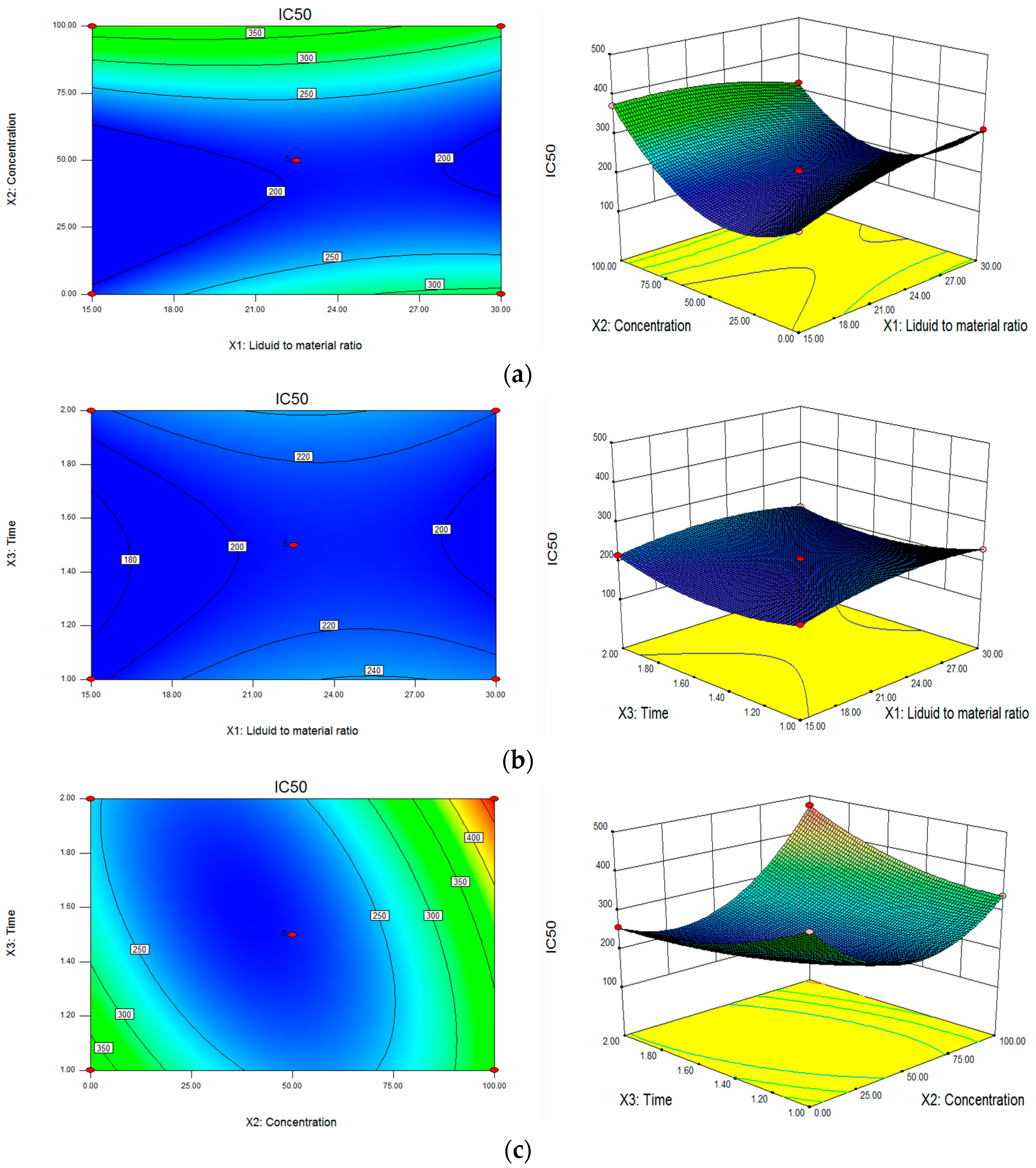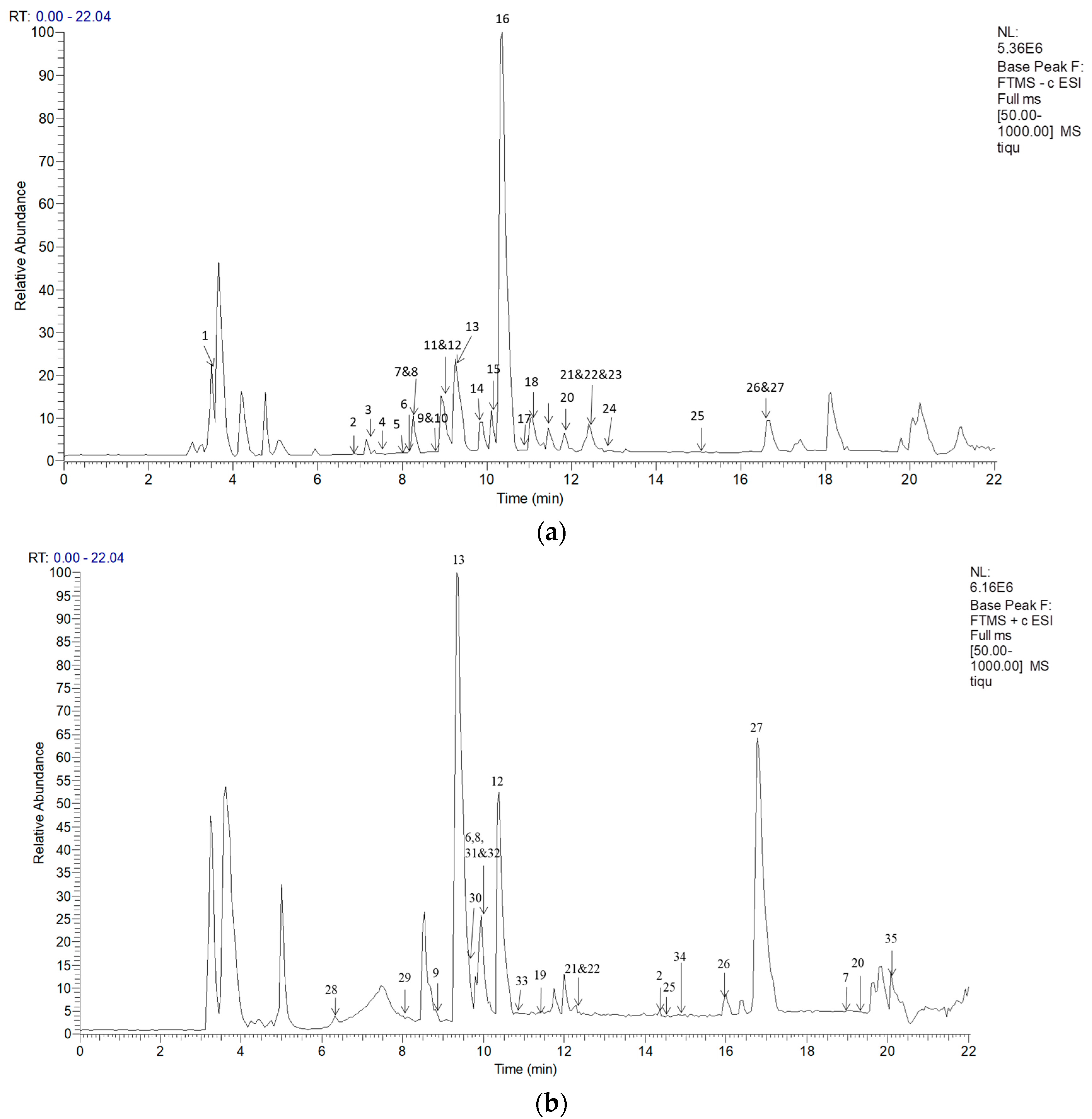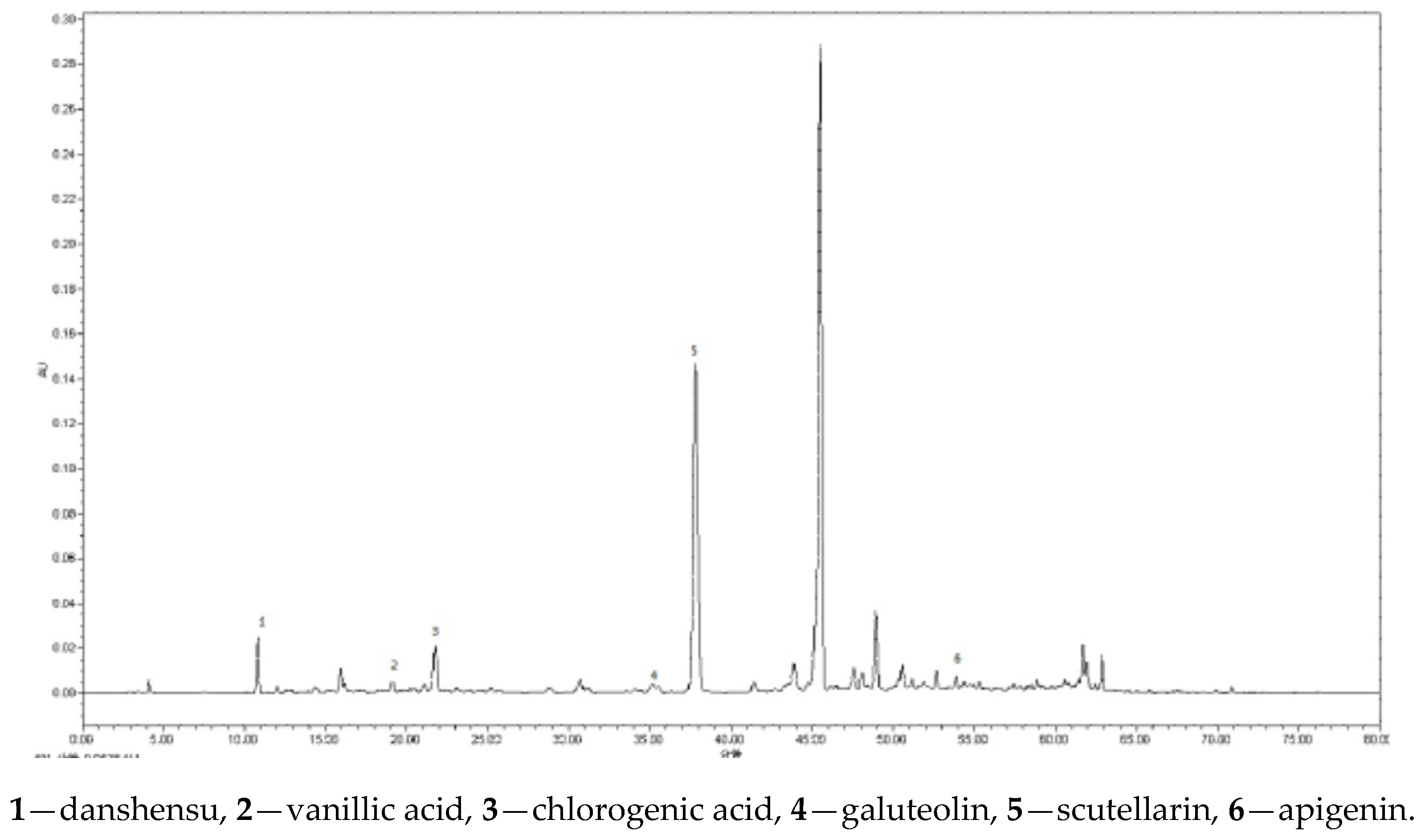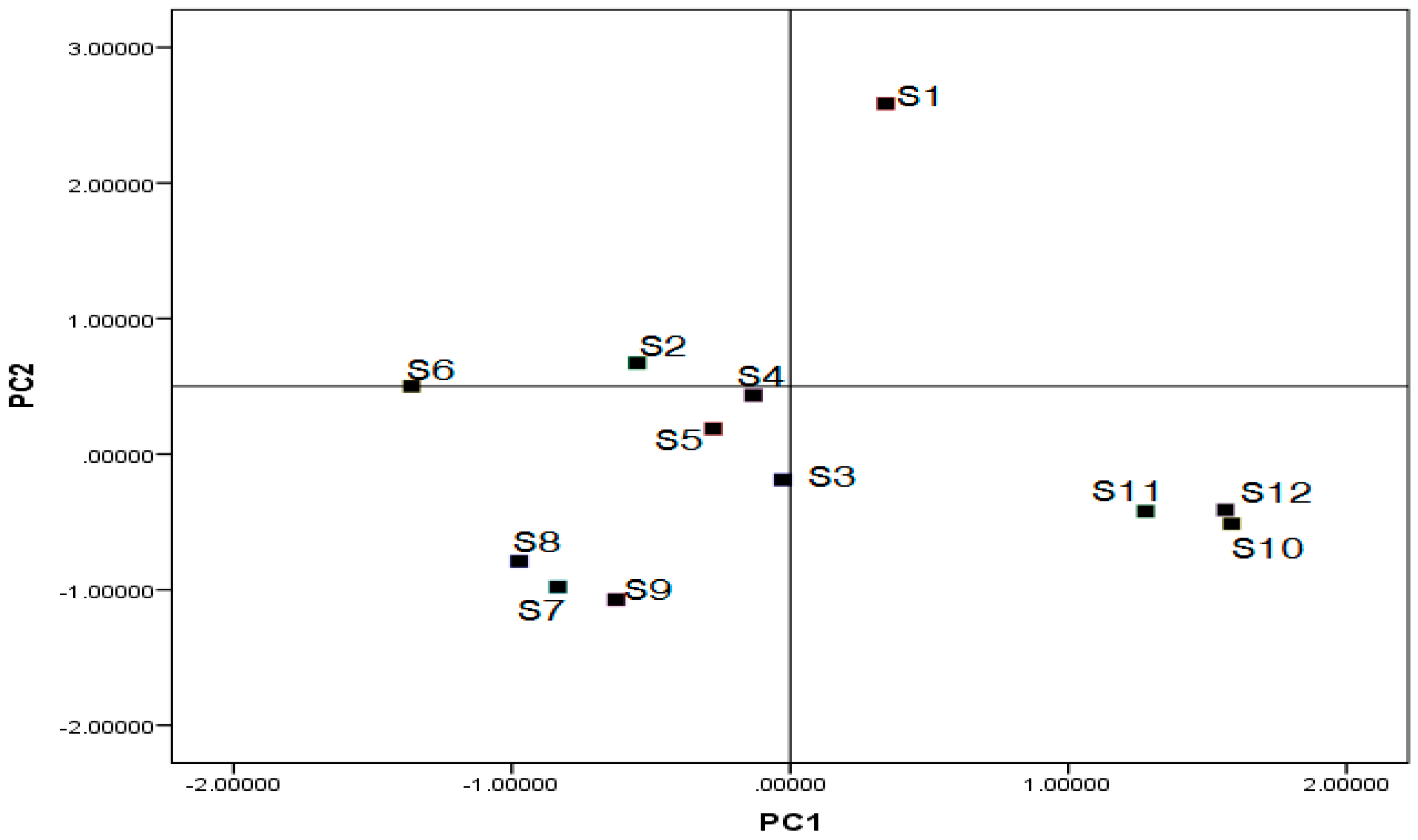1. Introduction
Cardiovascular disease (CVD) is the major cause of death and remains the No.1 killer in the world. It is known that oxidative stress is the main reason resulted in CVD. To find antioxidants from natural sources for clinic preventive medicine has become a hot issue [
1,
2,
3,
4]. Due to growing concerns among consumers about food safety, natural antioxidants have been searched to replace chemical additives [
5,
6]. It was reported that a great number of spice, aromatic, and medicinal plants containing abundant phenolic compounds exhibits obviously antioxidant properties [
5,
7,
8].
Thyme as a well-known fragrant plant is a kind of spice approved by the International Standard Organization [
9].
Thymus quinquecostatus Celak is a variety of thyme in China. It is primarily distributed in China, Korea, and Japan [
10]. This plant has been used as a food additive in cooking bacon and sausage because of its natural antiseptic action and was traditionally used as a tea-like beverage to dissipate heat and expel poison in China [
11,
12,
13,
14,
15,
16,
17]. It also has been widely used for the treatment of arthritis, kaschin-beck disease, acute gastroenteritis, and chronic stomachaches in the clinic nowadays [
18].
It is rich in essential oil of
T.quinquecostatus, which has been proved to have strong antioxidant capacity [
19,
20,
21]. When compared with its volatile oil,
T. quinquecostatus in-volatile part is poorly investigated, and there are few reports on its chemical composition and pharmacological activity [
22,
23,
24]. Our group reported that
T. quinquecostatus had a significant anti-cerebral ischemia effect. Several flavonoids and phenolic acids were isolated from its ethanol extract for the first time also displayed obvious anti-cerebral ischemia effect and applied in many fields of clinical medicine, especially scutellarin and danshensu as a most common medicament for the treatment of cerebral ischemia [
23,
25,
26]. According to the free radical theories, there is a great possibility that the anti-cerebral ischemia effect was due to its ability of eliminating free-radicals [
27,
28,
29].
In this study, for the scavenging free radicals activity being quick, easy to operate, and get clear phenomenon, we had attempted to develop a reliable method for the extraction of T. quinquecostatus, according to the scavenging free radicals activity by response surface methodology (RSM). An UPLC-MS2-based method was developed to detect the possible presence of 35 commercially available phenolic acids and flavonoids in this extract. Then, an effective HPLC method was established for the multi-component quantitative analysis, which possesses good antioxidant activity. Accordingly, chemometrics methods, principal components analysis (PCA) and hierarchical clustering analysis (HCA) were utilized to probe the relation between growing areas or harvest times, and the multi-component contents of this plant.
3. Materials and Methods
3.1. Materials and Reagents
The DPPH (2,2-Diphenyl-1-picrylhydrazyl, Sigma Co., Ltd., Croydon, UK) radical scavenging activity was determined using an ELISA microplate reader (Beijing Perlong New Technology Co., Ltd., Beijing, China) with 96-well plates (Nantong lineng Experiment Equipment Co., Ltd., Nantong, China). The T. quinquecostatus plant was obtained from yulin in Shaanxi province and qingyang and yanchi in the Gansu province in China. The samples were identified by Dr Shengjun Ma, department of Chinese Medicinal Resources, Beijing University of Chinese Medicine. Chlorogenic acid (Batch No. 110753), vanillic acid (Batch No. 110776-200402), scutellarin (Batch No. 110842-201207), galuteolin (Batch No. 111720-201307), apigenin (Batch No. 111901-201102), and danshensu (Batch No. 110855-201311) were reference compounds. Acetonitrile of HPLC-grade and LC-MS-grade was purchased from Fisher Scientific (Fair Lawn, NJ, USA). Phosphoric acid (Tianjin Fuchen Chemical Reagents Factory, Tianjin, China) and formic acid (Beijing Chemical works, Beijing, China) were HPLC grade. Ultra-pure waterused throughout the experiment was obtained from Guangzhou Watsons Food & Beverage Co., Ltd. (Guangzhou, China).
3.2. Optimization of Extraction Conditions
3.2.1. Design of the Extraction Method
RSM was employed to optimize the extraction conditions in terms of antioxidant activity. The design using a three-factor, three-level BBD comprised of 17 experimental points. The three independent variables examined were solid-liquid ratio (X
1), ethanol concentration (X
2), and extraction time (X
3). The actual values of each variable, which were predetermined by preliminary experiments, were coded at three levels (−1, 0, 1) for statistical analysis (
Table 7).
3.2.2. DPPH Radical Scavenging Activity Assay
The DPPH radical scavenging activity was determined, according to the method that was reported by Sharififar and others with some modifications [
47]. An equal amount of (1 mL of 0.15 mg) DPPH solution in 70% ethanol was mixed with 0.1 mL
T. quinquecostatus extract in 70% ethanol in various concentrations. After being mixed, the solution was allowed to reach a steady state at room temperature for approximately 1.5 h. The DPPH radical scavenging activity was determined by the absorbance at λ = 517 nm using a microplate reader and was calculated by the following Equation (2):
where A
0 is the absorbance of the control (blank, without extract) and A
1 is the absorbance of the mixture with the extract.
3.3. Preparation of Sample Solution
Sample preparation was conducted according to the above optimum extraction process with an ultrasonic cleansing bath. In brief, the crushed sample (approximately 2.0 g), accurately weighed, was transferred into a 100 mL conical flask with a stopper, and 40 mL of 45% ethanol solution was added, and was then ultrasonically extracted at room temperature for 1.5 h. The extracted solution was concentrated and filtered through 0.22 µm membrane filters before analysis. The contents of the selected compounds in T. quinquecostatus were obtained from the corresponding calibration curves.
3.4. Preparation of Standard Solution
Standard stock solutions of the six reference standards, vanillic acid (12.9 µg/mL), chlorogenic acid (100.0 µg/mL), danshensu (150.0 µg/mL), galuteolin (20.0 µg/mL), scutellarin (200.0 µg/mL), and apigenin (20.0 µg/mL) were prepared by dissolving the respective working standard substance in alcohol. The solutions were then diluted with alcohol to the concentrations required. All of the solutions were stored at 4 °C before use.
3.5. Instrument and UPLC-MS/MS Conditions
UPLC separations were optimized and finally performed on a Themo DIONEX UltiMate 3000 system (Thermo Fisher Scientific, Waltham, MA, USA) using a reverse-phase analytical column (3.6 μm, 4.6 × 150 mm, XDB-C18, Agilent, Santa Clara, CA, USA) at 30 °C with a 1.0 mL/min flow rate. 1 μL test solution was injected into the UPLC system. The mobile phase comprised acetonitrile (A) and 0.1% formic acid (B). The linear eluting gradient was as follows: 0–5 min, 5–30% A; 5–8 min, 30–52% A; 8–12 min, 52%A; 12–18 min, 52–95% A; 18–22 min, 95% A; 22–23 min, 95–5% A; and, 23–30 min, 5% A.
For the ESI-MS/MS experiment, a Thermo LTQ-Orbitrap Velos Pro Hybrid mass spectrometer (Thermo Fisher Scientific, Bremen, Germany), equipped with an ESI source operating in auto-MSn mode to obtain fragmentation in negative mode. Full scan data acquisition was performed from m/z 50 to 1000 in both negative and positive ion mode. The optimized ESI parameters in negative ion mode were set, as follows: capillary temperature of 350 °C; sheath gas flow rate of 40 arb; auxiliary gas flow rate of 10 arb; electrospray voltage of −3.5 V; and, tube lens voltage of −120 V. The electrospray voltage was 3.4 V and tube lens voltage was 120 V in positive ion mode; and other parameters were same as those of negative ion mode. The scan cycle employed a full-scan event at a resolution of 30,000. The most intense ions detected in the full-scan spectrum were selected for the data-independent scan. The collision energy for collision-induced dissociation (CID) was adjusted to 35% of the maximum. All of the instruments were controlled by the Xcalibur data system, and the data acquisition was carried out by analyst software Xcalibur 2.1 (Thermo Fisher Scientific, Waltham, MA, USA).
3.6. Instrument and HPLC Conditions
Quantitative analysis of 6 selected compounds were conducted on a Waters 2489 HPLC system (Waters Corporation (Shanghai), Shanghai, China), equipped with a breeze 2 data workstation, a UV detector and a manual injector. The separation was performed on a Thermo Hypersil GOLD C18 (5 μm, 4.6 × 250 mm, Thermo Fisher Scientific, Waltham, MA, USA) at 25 °C. The mobile phase comprising acetonitrile (solvent A) and 0.1% aqueous phosphoric acid (solvent B) was used to elute the target components with a gradient programme (0–5 min, 0–7% A; 5–l0 min, 7–13% A; 10–15 min, 13–15% A; 15–20 min, 15–18% A; 20–25 min, 18% A; 25–30 min, 18–20% A; 30–35 min, 20% A; 35–45 min, 20–28% A; 45–55 min, 28–40% A; 55–65 min, 40–80% A; 65–70 min, 80–100% A; and, 70–75 min, 100% A). The sample injection volume, flow rate, and detection wavelength were set at 10 μL, 1.0 mL/min, and 294 nm, respectively.
3.7. HPLC Method Validation
3.7.1. Linearity
The stock solutions containing the six analytes were prepared and diluted with alcohol to the appropriate concentration for construction of calibration curves. At least six concentrations of each compound were analysed under optimum HPLC conditions in triplicate, and the calibration curves were then constructed by plotting the peak areas compared with the concentration of each analyte. The regression equations were calculated in the form of y = ax + b, where y and x correspond to the peak area and concentration, respectively. The results are presented in
Table 4.
3.7.2. Precision, Repeatability, and Stability
The measurement of intra- and inter-day variability was utilized to evaluate the precision of the developed method. The intra-day precision was investigated for the mixed standards using six replicates within one day, and inter-day precision was determined in triplicate for three consecutive days. Variations were expressed by RSD.
The repeatability of the established method was examined at one level, and the T. quinquecostatus samples were extracted and analysed in triplicate using the previously mentioned method. The repeatability was presented as RSD (n = 6).
The stability of the sample solution was also assessed at room temperature. The same sample solution was analysed in triplicate at 0, 2, 4, 8, 12, 24, and 48 h. RSD was considered as a measure of stability.
Results regarding the stability as well as the precision and repeatability were summarized (
Table 4).
3.7.3. Accuracy
A recovery test was used to evaluate the accuracy of the developed method. Three quantities (low, medium, and high) of the six authentic standards were added to a certain amount of the sample with known contents of target analytes. The mixtures were then extracted and analysed, as described above.
3.8. Identification and Determination of 6 Components
According to the HPLC chromatogram ofsample solution and standard solution, the peak position of each component in the
T. quinquecostatus was determined (
Figure 3).
T. quinquecostatus plants, distributed in
qingyang,
jingbian and
yanchi, were harvested. The plants were gathered from July to October to obtain 12 batch samples and they were dried in a shady area. The extract was prepared according to
Section 3.3 and then analysed, as described above.
3.9. Data Analysis
Optimization of extraction conditions was conducted using the Design Expert software (Version 8.0.6.1, Stat-Ease Inc., Minneapolis, MN, USA) for regression analysis and variance (ANOVA) analysis. All 12 samples of T. quinquecostatus were classified by PCA and HCA using SPSS 20.0 software (IBM Company, Chicago, IL, USA).
4. Conclusions
To our best knowledge, the multi-responses optimization by RSM based on the DPPH radical scavenging activity was successfully implemented to evaluate the extraction of T. quinquecostatus for the first time. The established model exhibited favorable prediction ability and the alcoholic extract has a good antioxidant activity. In the extract, phenolic acids and flavonoids were main indicator ingredients according to the result of UPLC-MS/MS. Among them, xanthomicrol is firstly characterized in this herb. Then, six major active compounds were selected to analyze 12 batch samples. They were properly sorted on the basis of the active compounds’ content by PCA and HCA, and significant differences in the twelve different samples that were collected from different regions and harvest times were found. In summary, our work provides an easy approach that could markedly promote the study of the antioxidant parts of T. quinquecostatus, and establishes an effective quality evaluation method. Moreover, it has also the emphasized the chemical difference between samples from different growth environments, therefore contributing to the prominence of quality assurance and the efficacy of the medicinal plant.











